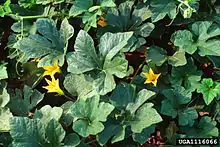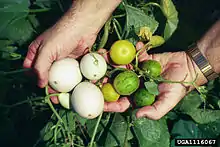Cucurbita texana
Cucurbita texana, also known as Cucurbita pepo subsp. texana and Texas gourd, is a mesophytic plant species of the genus Cucurbita.[3][2] It is native to Texas, primarily the southeastern region.[3] It is found only in the wild.[4] It is possibly a progenitor and close relative of the domesticated species Cucurbita pepo, though it and wild C. pepo are native to different areas. Cucurbita fraterna is also closely related. It was first collected 1835 by J. L. Berlandier in southern Texas. It was formally described as Tristemon texanus by George Heinrich Adolf Scheele in 1848 and transferred to the genus Cucurbita by Asa Gray in 1850.[1][4]
| Cucurbita texana | |
|---|---|
 | |
| C. texana plant and young blossoms | |
 | |
| C. texana fruit (left side) | |
| Scientific classification | |
| Kingdom: | Plantae |
| Clade: | Tracheophytes |
| Clade: | Angiosperms |
| Clade: | Eudicots |
| Clade: | Rosids |
| Order: | Cucurbitales |
| Family: | Cucurbitaceae |
| Genus: | Cucurbita |
| Species: | C. texana |
| Binomial name | |
| Cucurbita texana | |
| Synonyms[1][2] | |
Its usual habitat is in or near sandy riverbeds.[3]
The debate about the relationship of C. pepo, C. fraterna, and C. texana has been going on since at least 1857.[5] C. pepo has more similarities to C. fraterna than it does to C. texana which is also claimed to be an ancestor of C. pepo. The isozymes of C. pepo and C. fraterna are very similar. C. fraterna shares alleles with C. pepo at all 25 studied loci, indicating C. fraterna is the nearest relative of C. pepo.[6] C. pepo is most likely an early domesticated form of C. fraterna. It crosses well with both C. pepo and C. texana. C. pepo could be a compilospecies of C. fraterna and C. texana, which appear to be two species that were originally separate.[6][7][8] Based on genetic allele analysis, there are two distinct groups within C. pepo: pumpkin, calabaza, criolla, and marrow squash are in one, and ornamental gourds, crookneck squash, acorn squash, pattypan squash, and a few others are in the other. C. fraterna is genetically closer to the first group and C. texana is genetically closer to the second group.[9][10] No obvious constraints to gene flow between C. texana and C. pepo cultivars have been observed, regardless of which was the male or female parent; there is a distinct lack of reproductive isolation. However, the early origins of C. pepo in Mexico are well documented.[5]
References
- "Tristemon texanus Scheele". International Plant Names Index. 2005. Retrieved September 8, 2013.
- "Cucurbita texana". Germplasm Resources Information Network (GRIN). Agricultural Research Service (ARS), United States Department of Agriculture (USDA). Retrieved September 7, 2013.
- Nee, Michael (1990). "The Domestication of Cucurbita (Cucurbitaceae)". Economic Botany. New York: New York Botanical Gardens Press. 44 (3, Supplement: New Perspectives on the Origin and Evolution of New World Domesticated Plants): 56–68. doi:10.1007/BF02860475. JSTOR 4255271. S2CID 40493539.
- "Free-living Cucurbita pepo in the United States Viral Resistance, Gene Flow, and Risk Assessment". Texas A&M Bioinformatics Working Group. Retrieved September 8, 2013.
- Kirkpatrick, Kurt J.; Wilson, Hugh D. (1988). "Interspecific Gene Flow in Cucurbita: C. texana vs. C. pepo". American Journal of Botany. Botanical Society of America. 75 (4): 519–527. doi:10.2307/2444217. JSTOR 2444217.
- Andres, Thomas C. (1987). "Cucurbita fraterna, the Closest Wild Relative and Progenitor of C. pepo". Cucurbit Genetics Cooperative Report. Raleigh, NC: North Carolina State University. 10: 69–71.
- Singh, Ram J. (2003). Plant Cytogenetics (2 ed.). Boca Raton, FL: CRC Press, Taylor & Francis. p. 95. ISBN 978-0-8493-2388-1.
- Sanjur, Oris I.; Piperno, Dolores R.; Andres, Thomas C.; Wessel-Beaver, Linda (2002). "Phylogenetic Relationships among Domesticated and Wild Species of Cucurbita (Cucurbitaceae) Inferred from a Mitochondrial Gene: Implications for Crop Plant Evolution and Areas of Origin" (PDF). Proceedings of the National Academy of Sciences of the United States of America. Washington, DC: National Academy of Sciences. 99 (1): 535–540. Bibcode:2002PNAS...99..535S. doi:10.1073/pnas.012577299. JSTOR 3057572. PMC 117595. PMID 11782554.
- Soltis, Douglas E.; Soltis, Pamela S. (31 May 1990). Isozymes in Plant Biology. London: Dioscorodes Press. p. 176. ISBN 0-412-36500-6.
- Smith, Bruce D. (1992). Rivers of Change: Essays on Early Agriculture in Eastern North America. Tuscaloosa, AL: University of Alabama Press. pp. 71–73. ISBN 978-0-8173-5425-1.
